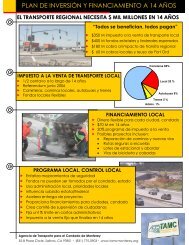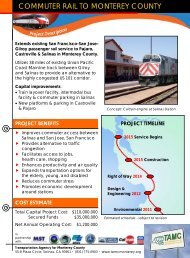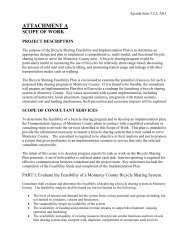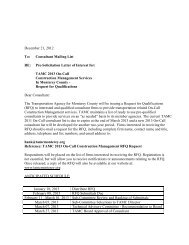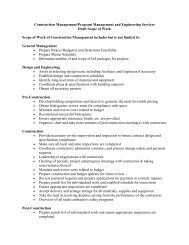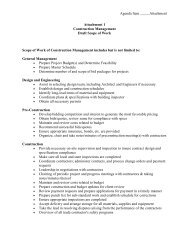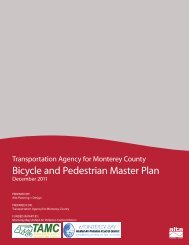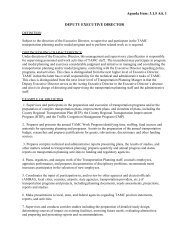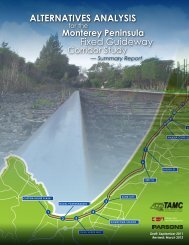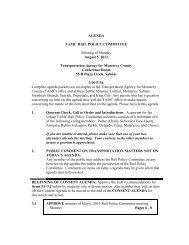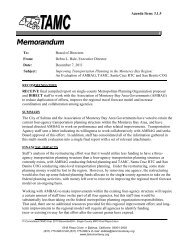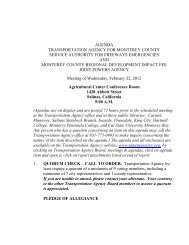156 Toll Road Study and Appendices - Transportation Agency for ...
156 Toll Road Study and Appendices - Transportation Agency for ...
156 Toll Road Study and Appendices - Transportation Agency for ...
- No tags were found...
Create successful ePaper yourself
Turn your PDF publications into a flip-book with our unique Google optimized e-Paper software.
Highway <strong>156</strong> Financial Feasbility AnalysisPage 7 of 10May 10, 2013capacity in 2025 that would be available <strong>for</strong> Phase 2. Costs associated with Phase 1 are fundedaccording to the construction draw schedule presented above.ResultsThe results presented here, based upon “sketch-level” traffic <strong>and</strong> revenue <strong>for</strong>ecasts, should beviewed as “sketch-level” financial feasibility results <strong>for</strong> the purposes of determining whether or notinitial results <strong>for</strong> Highway <strong>156</strong> demonstrate financial feasibility <strong>and</strong> should be studied in greaterdetail at the next stage.Presented below is a summary of funding sources <strong>and</strong> uses <strong>for</strong> the four scenarios. The total amountof borrowing required to fund Phase 1 is approximately $86 million <strong>for</strong> each scenario. $69.8 milliongoes towards project construction, with approximately $6.7 million going into bond <strong>and</strong> TIFIA debtservice reserve funds <strong>and</strong> approximately $7.5 million used to pay interest costs during theconstruction period (i.e., capitalized interest). The remainder is used <strong>for</strong> transaction costs.Summary of Funding Sources & UsesScenario A Scenario B Scenario C Scenario DPhase 1 only Phase 1&2 Phase 1 only Phase 1&2SourcesRevenue Bonds ‐ Phase 1 47,110,000 46,800,000 46,510,000 47,325,000TIFIA Loan (33% of eligible costs) 39,339,638 39,330,068 39,320,003 39,347,228Total Borrowing ‐ Phase 1 86,449,638 86,130,068 85,830,003 86,672,228Construction Fund Interest Earnings 107,207 107,236 107,274 107,1762025 Bond Capacity ‐ Phase 2 ‐ 95,555,000 ‐ 119,130,000Total Sources 86,556,845 181,792,305 85,937,278 205,909,405UsesPhase 1 Construction Costs 69,847,804 69,847,797 69,847,802 69,847,798Debt Service Reserve Fund 6,677,982 6,646,503 6,617,000 6,699,861Capitalized Interest Fund 7,592,851 7,503,464 7,499,812 7,579,029Underwriters' Discount 282,660 280,800 279,060 283,950Other Cost of Issuance 2,155,548 1,958,739 1,693,604 2,368,766Phase 2 ‐ Additional Bond Capacity ‐ 95,555,000 ‐ 119,130,000Total Uses 86,556,845 181,792,305 85,937,278 205,909,405Scenarios B <strong>and</strong> D identify the amount of additional bond proceeds that are available in 2025 <strong>for</strong>Phase 2 funding needs. Under Scenario B, there is estimated to be approximately $95.5 million inbond proceeds available in 2025. Under Scenario D, there is estimated to be approximately $119million in bond proceeds available in 2025. These estimates are gross bond proceeds: the cost ofcapitalized interest, debt service reserve funds, costs of issuance, etc., needs to be netted from thisgross number to determine dollars available <strong>for</strong> construction. These amounts can add up to 20% to30% of the par amount, depending on structure, construction schedule <strong>and</strong> other factors. As such,net bond proceeds <strong>for</strong> construction can range from $67 million to $76 million <strong>for</strong> Scenario B, to $83million to $95 million <strong>for</strong> Scenario D.



